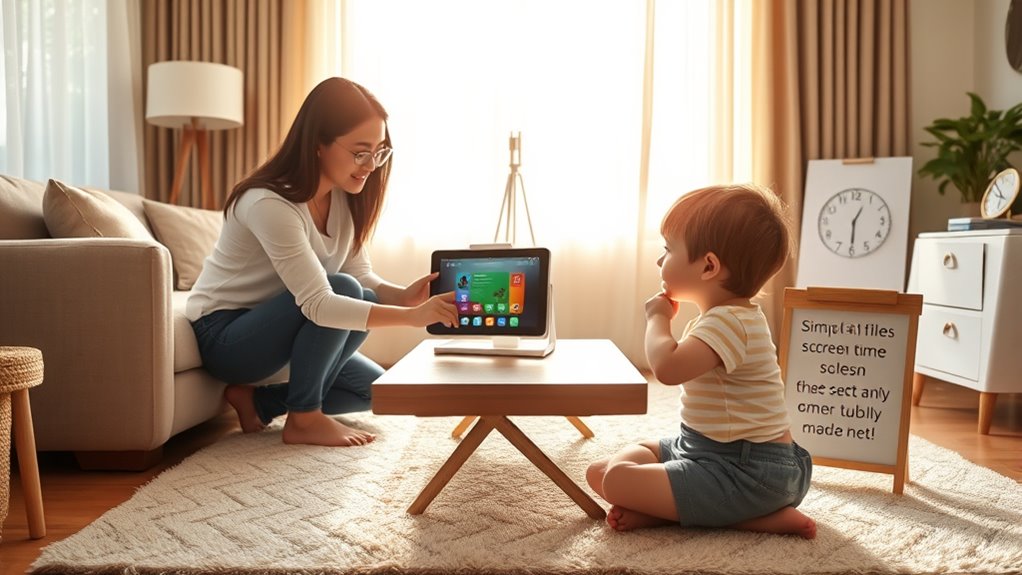To set healthy screen time boundaries without power struggles, communicate clearly and involve others in creating rules. Establish consistent, scheduled tech-free zones and times, like during meals or before bed, and use tools to monitor usage. Focus on activities that promote connection and mindfulness, such as offline hobbies or face-to-face chats. By fostering shared goals and patience, you can create a balanced digital environment. Keep exploring practical tips to make the process smoother and more effective.
Key Takeaways
- Clearly communicate boundaries and reasons to foster understanding and buy-in from everyone involved.
- Involve family or friends in setting goals to promote shared commitment and reduce resistance.
- Establish predictable routines and designated tech-free times to create consistency and minimize conflicts.
- Use timers, app controls, and physical cues to monitor and enforce boundaries gently.
- Focus on positive offline activities and quality interactions to make boundaries feel rewarding rather than restrictive.

In today’s digital age, setting healthy screen time boundaries is essential for maintaining your well-being and fostering balanced habits. With constant notifications and endless scrolling, it’s easy to feel overwhelmed or disconnected from the world around you. One effective way to regain control is by establishing regular digital detox periods—times when you intentionally disconnect from screens altogether. These detoxes help reset your mind, reduce eye strain, and improve focus. To make this sustainable, create designated tech free zones in your home, such as the dining room or bedrooms, where screens are discouraged. These zones serve as physical boundaries that reinforce your commitment to healthier habits and foster quality interactions with family and friends.
Start by clearly defining your limits. Decide how much time you want to spend on devices daily and stick to it. Using timers or app-based controls can help you monitor your usage without constant effort. Communicate these boundaries to others so they understand your intentions and can support your goals. When you’re in your tech free zones, commit to engaging in offline activities—reading, crafting, or simply enjoying conversation. This shift not only reduces screen time but also encourages deeper connections and mindfulness. Vetted resources are also available to help you select suitable tools to track and manage your screen time effectively.
Creating a routine around your digital detox can make it easier to uphold. For example, designate certain hours as screen-free, like during breakfast or an hour before bed. This routine reinforces the habit and provides predictable breaks from digital devices. Remember, the goal isn’t to eliminate screens entirely but to create a healthy balance. By intentionally planning these detox periods, you prevent power struggles that often arise when boundaries are imposed harshly or suddenly. Instead, you foster an environment of cooperation and understanding, making it more likely that everyone will respect the boundaries.
To stay consistent, consider involving others in your efforts. Share your goals with family or friends and encourage them to join you in tech free zones. When everyone participates, it becomes a shared commitment, lessening any resistance or guilt. Over time, these boundaries become natural parts of your routine, helping you avoid the trap of endless scrolling or overuse. Remember that setting boundaries isn’t about deprivation; it’s about creating space for meaningful offline experiences, reducing stress, and promoting healthier digital habits. With patience and persistence, you’ll find that establishing these boundaries enhances your overall well-being without power struggles, making your digital life more intentional and balanced.
Frequently Asked Questions
How Can I Model Healthy Screen Habits for My Children?
You can model healthy screen habits by consistently demonstrating balanced use yourself. Set clear boundaries around your screen time, such as no devices during meals or before bed, and stick to them. When your children see you practicing these boundaries daily, they’ll learn to do the same. Modeling consistency shows your kids that maintaining healthy habits is important, making it easier for them to follow suit without power struggles.
What Are Effective Ways to Handle Resistance to Screen Limits?
Handling resistance to screen limits is like steering a boat through choppy waters—you need patience and steady guidance. When faced with pushback, stay firm but gentle, emphasizing positive reinforcement for respecting boundaries. Explain the reasons behind the limits, listen to concerns, and celebrate small successes. This approach encourages cooperation, making it easier for your child to accept boundaries without power struggles, fostering a healthier relationship with screens.
How Do I Balance Screen Time With Outdoor Activities?
You can balance screen time with outdoor activities by scheduling regular digital detox periods where screens are off, encouraging outdoor engagement instead. Plan fun outdoor activities like biking, hiking, or sports that captivate your child’s interest. Set clear boundaries for screen use, and make outdoor time a non-negotiable part of daily routines. This approach helps your child develop healthier habits while enjoying the benefits of fresh air and physical activity.
Are There Recommended Screen Time Limits for Different Age Groups?
You might worry about strict limits, but setting age-appropriate screen time helps your child develop healthy habits. For younger kids, aim for no more than one hour daily, encouraging a digital detox during meals and tech-free zones at bedtime. Older children can have up to two hours, with scheduled breaks. These boundaries foster balance, reduce screen dependence, and promote meaningful outdoor experiences without power struggles.
How Can I Monitor Screen Time Without Invading Privacy?
You can monitor screen time without invading privacy by using monitoring tools that respect boundaries. Choose apps that track usage and set limits without detailed content inspection, so you address privacy concerns. Communicate openly about why you’re monitoring and involve your child in setting rules. This approach fosters trust, making it easier to oversee screen time while respecting privacy and avoiding power struggles.
Conclusion
By setting clear screen time boundaries, you create a balanced routine that benefits everyone. Imagine your teen finishing homework with limited screen time, then outside playing with friends instead of endless scrolling. Consistent boundaries reduce power struggles and build trust. Remember, it’s about guiding rather than restricting, helping your child develop healthy habits. With patience and clarity, you’ll foster a positive environment where screens support, not hinder, their growth.










